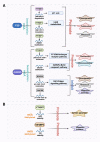The diverse role of RNA methylation in esophageal cancer
- PMID: 37070847
- PMCID: PMC10326421
- DOI: 10.3724/abbs.2023057
The diverse role of RNA methylation in esophageal cancer
Abstract
Esophageal cancer is one of the major life-threatening diseases in the world. RNA methylation is the most common post-transcriptional modification and a wide-ranging regulatory system controlling gene expression. Numerous studies have revealed that dysregulation of RNA methylation is critical for cancer development and progression. However, the diverse role of RNA methylation and its regulators in esophageal cancer remains to be elucidated and summarized. In this review, we focus on the regulation of major RNA methylation, including m 6A, m 5C, and m 7G, as well as the expression patterns and clinical implications of its regulators in esophageal cancer. We systematically summarize how these RNA modifications affect the "life cycle" of target RNAs, including mRNA, microRNA, long non-coding RNA, and tRNA. The downstream signaling pathways associated with RNA methylation during the development and treatment of esophageal cancer are also discussed in detail. Further studies on how these modifications function together in the microenvironment of esophageal cancer will draw a clearer picture of the clinical application of novel and specific therapeutic strategies.
Keywords: 5-methylcytosine; 7-methylguanosine; N6-methyladenosine; RNA methylation; esophageal cancer; post-transcriptional modification; tumor microenvironment.
Conflict of interest statement
The authors declare that they have no conflict of interest.
Figures




Similar articles
-
Comprehensive Analysis of PD-L1 Expression, Immune Infiltrates, and m6A RNA Methylation Regulators in Esophageal Squamous Cell Carcinoma.Front Immunol. 2021 May 12;12:669750. doi: 10.3389/fimmu.2021.669750. eCollection 2021. Front Immunol. 2021. PMID: 34054840 Free PMC article.
-
Role of identified RNA N6-methyladenosine methylation in liver.Anal Biochem. 2019 Aug 1;578:45-50. doi: 10.1016/j.ab.2019.05.005. Epub 2019 May 7. Anal Biochem. 2019. PMID: 31075230 Review.
-
N6-methyladenosine RNA modification and its interaction with regulatory non-coding RNAs in colorectal cancer.RNA Biol. 2021 Nov 12;18(sup2):551-561. doi: 10.1080/15476286.2021.1974749. Epub 2021 Oct 21. RNA Biol. 2021. PMID: 34674600 Free PMC article. Review.
-
Novel Insights Into the Role of N6-Methyladenosine RNA Modification in Bone Pathophysiology.Stem Cells Dev. 2021 Jan 1;30(1):17-28. doi: 10.1089/scd.2020.0157. Epub 2020 Dec 21. Stem Cells Dev. 2021. PMID: 33231507 Review.
-
The roles and mechanism of m6A RNA methylation regulators in cancer immunity.Biomed Pharmacother. 2023 Jul;163:114839. doi: 10.1016/j.biopha.2023.114839. Epub 2023 May 8. Biomed Pharmacother. 2023. PMID: 37156113 Review.
Cited by
-
The potential of MCM8 as a biomarker in esophageal carcinoma: a comprehensive analysis integrating m6a methylation and angiogenesis.Eur J Med Res. 2025 May 9;30(1):373. doi: 10.1186/s40001-025-02541-3. Eur J Med Res. 2025. PMID: 40346692 Free PMC article.
-
Dysregulation of tRNA methylation in cancer: Mechanisms and targeting therapeutic strategies.Cell Death Discov. 2024 Jul 17;10(1):327. doi: 10.1038/s41420-024-02097-x. Cell Death Discov. 2024. PMID: 39019857 Free PMC article. Review.
-
METTL3-mediated m 6A modification of pri-miRNA-31 promotes hypertrophic scar progression.Acta Biochim Biophys Sin (Shanghai). 2025 Mar 18;57(7):1106-1114. doi: 10.3724/abbs.2025033. Acta Biochim Biophys Sin (Shanghai). 2025. PMID: 40109092 Free PMC article.
-
METTL3 drives NSCLC metastasis by enhancing CYP19A1 translation and oestrogen synthesis.Cell Biosci. 2024 Jan 18;14(1):10. doi: 10.1186/s13578-024-01194-9. Cell Biosci. 2024. PMID: 38238831 Free PMC article.
-
Exploring the underlying biology of cancer and potential therapeutic strategies: a special issue focused on mechanism-based studies.Acta Biochim Biophys Sin (Shanghai). 2023 Jun 19;55(6):891-892. doi: 10.3724/abbs.2023114. Acta Biochim Biophys Sin (Shanghai). 2023. PMID: 37337636 Free PMC article. No abstract available.
References
-
- Sung H, Ferlay J, Siegel RL, Laversanne M, Soerjomataram I, Jemal A, Bray F. Global cancer statistics 2020: GLOBOCAN estimates of incidence and mortality worldwide for 36 cancers in 185 countries. CA Cancer J Clin. . 2021;71:209–249. doi: 10.3322/caac.21660. - DOI - PubMed
-
- Morgan E, Soerjomataram I, Rumgay H, Coleman HG, Thrift AP, Vignat J, Laversanne M, et al. The global landscape of esophageal squamous cell carcinoma and esophageal adenocarcinoma incidence and mortality in 2020 and projections to 2040: new estimates from GLOBOCAN 2020. Gastroenterology. . 2022;163:649–658.e2. doi: 10.1053/j.gastro.2022.05.054. - DOI - PubMed
-
- Li S, Chen H, Man J, Zhang T, Yin X, He Q, Yang X, et al. Changing trends in the disease burden of esophageal cancer in China from 1990 to 2017 and its predicted level in 25 years. Cancer Med. . 2021;10:1889–1899. doi: 10.1002/cam4.3775. - DOI - PMC - PubMed
-
- Esteller M. Cancer epigenomics: DNA methylomes and histone-modification maps. Nat Rev Genet. . 2007;8:286–298. doi: 10.1038/nrg2005. - DOI - PubMed
Publication types
MeSH terms
Substances
LinkOut - more resources
Full Text Sources
Medical

